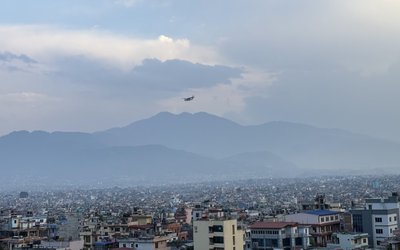The Old Testament in the Bible states that it was God who gave the Ten Commandments to Moses and it was with this that the Jews were governed and regulated their lives. There was at that time no separation of the administration and religion.
In his book ‘Last of the Aryans’ author Bhagwan Gidwani tells the story of the early rulers of India or Bharatbarsha when the Aryans held sway over the land. They chose as their ruler one, with the capability to lead them against invaders and protect the people of the community. The people at large were wanderers over the lands of Asia and Europe and their race was symbolized by the Swastika.
In that book we read too about the Rishi Munis coming to the Himalayas to meditate to attain salvation. The movement to the hills for salvation increased many fold during the course of the Muslim invasions of India, which were said to have started with the establishment of the Delhi Sultanate and resulted in the spread of Islam during the 12-16th Centuries. It was to the hills of the Himalayan ranges that the locals of India migrated to protect themselves, their mores and their religion from the invaders. The Muslim Moguls were followed in course of time by the British as the new rulers of India.
At about this same time the herders of the mountain goats and yaks from the Northern region of the Himalayas migrated down towards the warmer Southern climes of the mountainous regions to ensure that their animals had something to graze on.
Then emerged Prithvi Narayan Shah, who by victories over petty rulers and pronouncing that Nepal is a ‘Garden of thirty-six castes and four colours’ laid the foundation of what is now Nepal. Was he then pre-voicing the thoughts of Chairman Mao who said, “Let a thousand flowers bloom”? Prithvi Narayan was ahead of his time when he pronounced that Nepal had to be careful, being like ‘A yam betwixt two stones’, a situation that exists even today.
The East India Company of the British, when they fought and took over many Indian states may have restricted the concept of a Greater Nepal but did not bother to annex it. They probably realized that this mountainous country would require more in the way of investments than give them returns. They in their wisdom or otherwise, decided to recruit the Nepalis into their Gurkha army, dissuading them at the same time from going to Lahore to join Maharaja Ranjit Singh’s forces. However, the Nepalis as a ‘Nation of Migrants’ not only went there but also to Tibet, Bhutan and parts of India as traders or labourers. The reality of Nepalis is that we have, over the ages become a collection of people where a lot of genetic pooling has taken place. No wonder that many anthropologists term Nepal as ‘An anthropologist’s delight’!
What must be always kept in the back of our Nepali minds is that our country literally came out of the ocean many million years ago as a result of the abutting of land masses in such manner that the Himalayas rose out of the waters to form the highest peak on the earth. The heritage of all this are the Saligrams that abound in North West Nepal. The Nepalis have had to exist down the ages with isolation and hardships. All this has resulted in a population that, as a whole comprises of simple tolerant people, not prone to bursts of emotion and anger. They have existed in a state of ‘live and let live’, in a country where communication till recently was almost non-existent. Now times are changing and the old order of caste and creed are in a process of being broken down.
Nepalis are now is in a state of flux. They are going still further afield. Many Nepalis are working, not only in India and the Gulf but in many other parts of the world too. During the course of the last decade as many as 80 thousand Bhutanese of Nepali origin have gone to the States and almost one hundred thousand Gurkha are estimated to have gone to the UK on a permanent basis. They are all part of the Nepali diaspora of the future. So what and who is Nepali? By this we, as a country, mean both ourselves and our language. As many popular songs state, it means both ‘Nepaliman’ and ‘Nepalipan’.
Now many Nepalis born abroad can claim citizenship of that respective land where they are born, as a birth right. We in Nepal utter phrases such as, ‘Males and females are equal and necessary as the two wheels of a chariot’, but are loathe to putting it into practice. Basic pay, in many instances, varies according to gender. More disturbing is the fact that citizenship of a child is still not given the basis of mother’s nationality though it is she who has carried the foetus for nine months in the womb! Our new constitution, whenever it comes out should at least correct this injustice.
Over thirty years ago Ernest Remen delivered to the students at Sorbonne in Paris an address entitled, “What is a Nation?” He concluded by stating, “Man is a slave neither of his race nor his language, nor his religion, nor of rivers nor of the direction taken by mountain chains. A large aggregate of men, healthy in mind and warm of heat , creates the king of moral conscience which we call a nation.”

Hemang Dixit
The author writes fiction under the name of Mani Dixit. Website: www.hdixit.org.np. Twitter: @manidixithd
- Top Heavy
- Sep 20, 2023
- Most Able?
- Sep 04, 2023
- Changing Times
- Aug 21, 2023
- Nepali Shenanigans
- Aug 03, 2023
- Budget Naataks
- Jun 29, 2023














